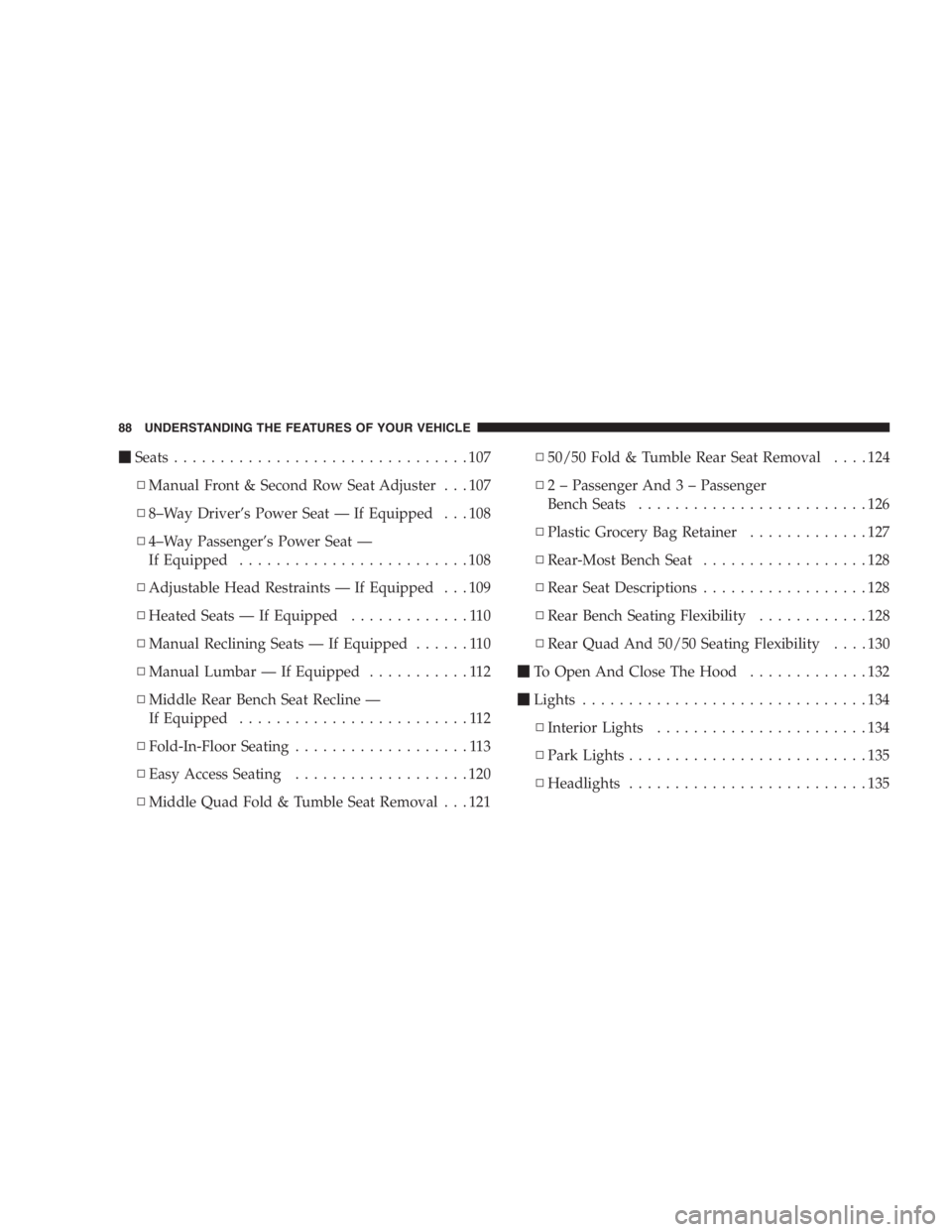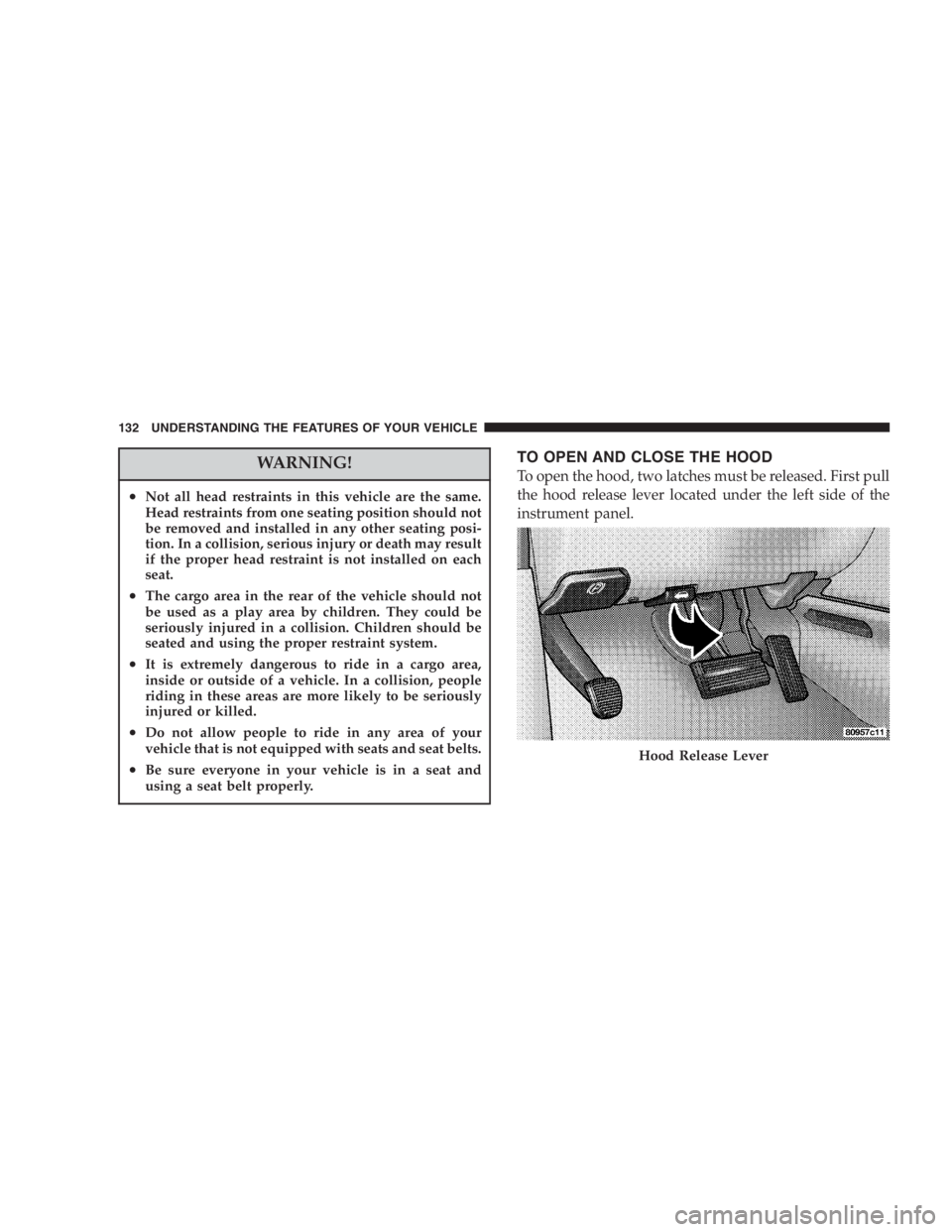Page 88 of 480

� Seats ................................107
▫ Manual Front & Second Row Seat Adjuster . . . 107
▫ 8 – Way Driver ’ s Power Seat — If Equipped . . . 108
▫ 4 – Way Passenger ’ s Power Seat —
If Equipped .........................108
▫ Adjustable Head Restraints — If Equipped . . . 109
▫ Heated Seats — If Equipped .............110
▫ Manual Reclining Seats — If Equipped ......110
▫ Manual Lumbar — If Equipped ...........112
▫ Middle Rear Bench Seat Recline —
If Equipped .........................112
▫ Fold-In-Floor Seating ...................113
▫ Easy Access Seating ...................120
▫ Middle Quad Fold & Tumble Seat Removal . . . 121 ▫ 50/50 Fold & Tumble Rear Seat Removal ....124
▫ 2 – Passenger And 3 – Passenger
Bench Seats .........................126
▫ Plastic Grocery Bag Retainer .............127
▫ Rear-Most Bench Seat ..................128
▫ Rear Seat Descriptions ..................128
▫ Rear Bench Seating Flexibility ............128
▫ Rear Quad And 50/50 Seating Flexibility ....130
� To Open And Close The Hood .............132
� Lights ...............................134
▫ Interior Lights .......................134
▫ Park Lights ..........................135
▫ Headlights ..........................13588 UNDERSTANDING THE FEATURES OF YOUR VEHICLE
Page 132 of 480

WARNING!• Not all head restraints in this vehicle are the same.
Head restraints from one seating position should not
be removed and installed in any other seating posi-
tion. In a collision, serious injury or death may result
if the proper head restraint is not installed on each
seat.
• The cargo area in the rear of the vehicle should not
be used as a play area by children. They could be
seriously injured in a collision. Children should be
seated and using the proper restraint system.
• It is extremely dangerous to ride in a cargo area,
inside or outside of a vehicle. In a collision, people
riding in these areas are more likely to be seriously
injured or killed.
• Do not allow people to ride in any area of your
vehicle that is not equipped with seats and seat belts.
• Be sure everyone in your vehicle is in a seat and
using a seat belt properly. TO OPEN AND CLOSE THE HOOD
To open the hood, two latches must be released. First pull
the hood release lever located under the left side of the
instrument panel.
Hood Release Lever132 UNDERSTANDING THE FEATURES OF YOUR VEHICLE
Page 133 of 480
Next, push to the left the safety catch located under the
front edge of the hood, near the center.
Use the hood prop rod to secure the hood in the open
position. To prevent possible damage, do not slam the hood to
close it. Lower the hood until it is open approximately 30
cm (12 inches) and then drop it. This should secure both
latches. Never drive your vehicle unless the hood is fully
closed, with both latches engaged.
WARNING!If the hood is not fully latched, it could fly up when
the vehicle is moving and block your forward vision.
You could have a collision. Be sure all hood latches
are fully latched before driving.Hood Safety Catch UNDERSTANDING THE FEATURES OF YOUR VEHICLE 133
3
Page 394 of 480

Cooling System
Inspection
WARNING!• When working near the radiator cooling fan, turn
the ignition key to the OFF position. The fan is
temperature controlled and can start at any time
when the ignition key is in the ON position.
• You or others can be badly burned by hot coolant
or steam from your radiator. If you see or hear
steam coming from under the hood, don ’ t open
the hood until the radiator has had time to cool.
Never try to open a cooling system pressure cap
when the radiator is hot. Coolant Checks
Check engine coolant (antifreeze) protection every 12
months (before the onset of freezing weather, where
applicable). If coolant is dirty or rusty in appearance, the
system should be drained, flushed and refilled with fresh
coolant. Check the front of the A/C condenser for any
accumulation of bugs, leaves, etc. If dirty, clean by gently
spraying water from a garden hose vertically down the
face of the condenser.
Check the coolant recovery bottle tubing for brittle rub-
ber, cracking, tears, cuts and tightness of the connection
at the bottle and radiator. Inspect the entire system for
leaks.
With the engine at normal operating temperature (but
not running), check the coolant pressure cap for proper
vacuum sealing by draining a small amount of coolant
from the radiator drain cock. If the cap is sealing prop-
erly, the coolant will begin to drain from the coolant394 MAINTAINING YOUR VEHICLE
Page 464 of 480

Fuel System Caution ..................... 332
Fueling ............................... 334
Fuses ................................ 412
Garage Door Opener ..................... 159
GasCap .............................. 334
Gasoline .............................. 330
Gasoline, Clean Air ...................... 331
Gasoline, Reformulated ................... 331
Gauges
Coolant Temperature .................... 200
Fuel ................................ 196
Speedometer ......................... 197
Tachometer .......................... 199
Gearshift .............................. 299
General Information .................. 16,25,327
Glass Cleaning .......................... 409
Grocery Bag Retainer ..................... 127
Gross Axle Weight Rating .................. 336 Gross Vehicle Weight Rating ................ 336
Hands-Free Phone ........................ 96
Hazard Warning Flasher ................... 344
Head Phones ........................... 252
Head Restraints ......................... 109
Headlights ............................ 135
Bulb Replacement ...................... 416
High Beam/Low Beam Select Switch ........ 139
Lights On Reminder .................... 137
Replacing ............................ 416
Time Delay .......................... 138
Heated Seats ........................... 110
Heater ............................... 262
Heater, Engine Block ..................... 296
Homelink Transmitter .................... 159
Hood Release .......................... 132
Hoses ............................. 399,402464 INDEX